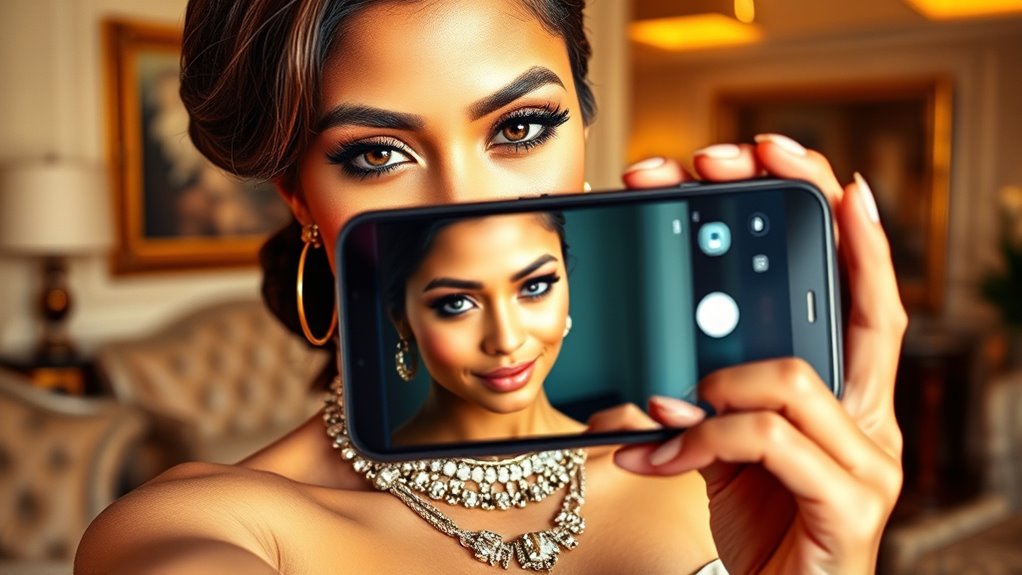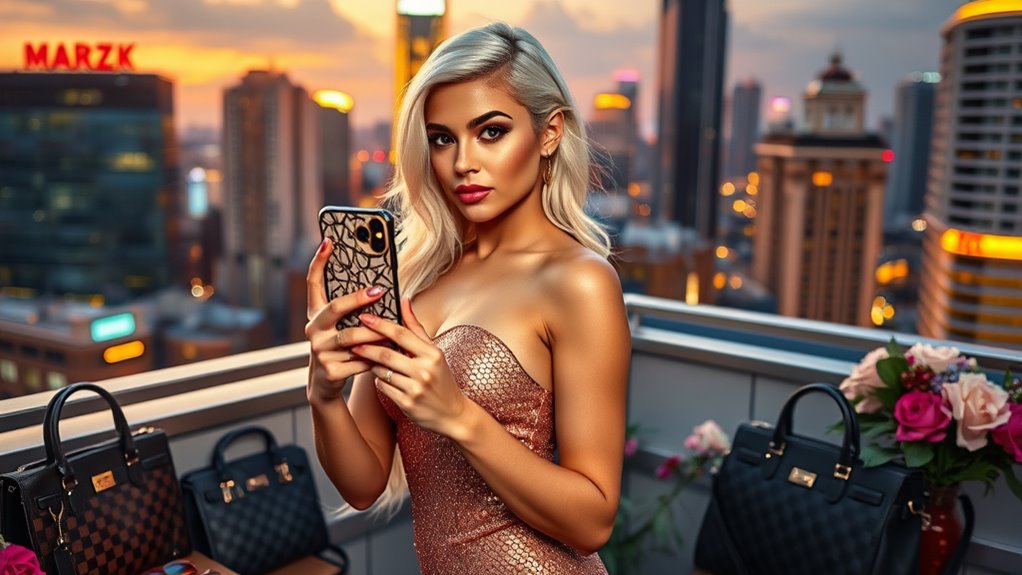On Instagram, female narcissists craft perfect, curated images to constantly seek validation. They post frequent selfies, highlight achievements, and use hashtags and tags to boost their presence. Their content is designed to attract likes, comments, and admiration, fueling a cycle of validation that boosts self-esteem. Cultural norms and gender expectations influence their self-promotion tactics. If you keep exploring, you’ll uncover more about how these habits sustain their online personas and psychological motives.
Key Takeaways
- Female narcissists frequently post curated selfies emphasizing beauty and luxury to garner validation and boost self-esteem.
- They strategically use hashtags, tags, and timing to maximize reach, engagement, and perceived social status.
- Content often highlights achievements, possessions, and aesthetic perfection to reinforce an idealized self-image.
- They rely heavily on likes, comments, and followers for external validation, influencing their online behavior.
- Engagement is driven by emotional appeals, exclusivity, and provocative posts to maintain attention and admiration.
The Allure of Selfie Posting and Visual Self-Presentation

The appeal of selfie posting and visual self-presentation on platforms like Instagram primarily stems from the desire for validation and admiration. As a female user, you may notice that narcissistic traits drive you to share more selfies than others, seeking positive feedback. You might curate and edit your images to highlight your physical appeal, believing your selfies are more attractive than those of others. This process reinforces your self-image and boosts confidence. Frequent profile picture changes and posting only the best shots become routines to emphasize your evolving attractiveness. You often post selfies instead of group photos or captions, relying on likes and comments to affirm your worth. This cycle creates a dependency on external validation, fueling your motivation to maintain an idealized visual self-presentation. The Social media behaviors involved are complex and may also be influenced by factors such as gender, location, and different types of narcissism. Additionally, understanding the underlying motivations can help you recognize patterns of narcissistic traits that drive these habits. Recognizing the importance of self-image management can also shed light on why these habits become so ingrained. Moreover, these behaviors are often reinforced by the social validation received, which can create a cycle of continual self-promotion.
Strategies of Self-Promotion and Audience Engagement

To boost visibility and foster engagement, content creators often use strategic tagging, captions, and hashtags that reach wider audiences. By carefully selecting tags and crafting compelling captions, they encourage interactions that elevate their posts in the algorithm. Understanding how to optimize these elements can markedly amplify self-promotion efforts and audience connection. This intentional manipulation of online cues further reinforces the cycle of validation and persona building central to narcissistic online behaviors. Additionally, awareness of cookie preferences can help creators tailor their engagement strategies while respecting user privacy. Employing privacy management practices ensures that their strategies align with user expectations and legal requirements. Moreover, leveraging romantic love shayari and other emotionally engaging content can significantly increase audience resonance and sharing potential. Recognizing the influence of prophetic dreams on subconscious motivations can also inspire more authentic and impactful content creation strategies.
Strategic Content Tagging
Strategic content tagging serves as a powerful tool for self-promotion and audience engagement by allowing you to enhance your visibility and project a curated image. If you have grandiose tendencies, you’ll tag high-status accounts like influencers, brands, or celebrities to boost your perceived importance and align your content with an aspirational lifestyle. You’ll focus on tags that increase your reach in competitive spaces, attracting followers who admire success and luxury. Vulnerable narcissists use tagging to seek validation, tagging emotionally supportive accounts or niche communities to trigger reciprocation. They also tag authority figures or trending challenges to stay relevant. Additionally, tagging geographic locations and professional roles helps project sophistication and stability, reinforcing your self-image and maintaining a sense of control within your online persona. Research indicates that problematic social media use is often linked to narcissistic traits, as individuals seek constant validation and admiration online. Incorporating color accuracy and other visual enhancements in your posts can further elevate your curated image and appeal. Understanding the visual presentation behind your tags can amplify their effectiveness, making your self-promotion even more impactful. Moreover, utilizing specialized content tags related to unique interests or niches can help differentiate your profile and attract a more engaged audience.
Caption and Hashtag Tactics
Effective caption and hashtag tactics amplify your self-promotion and deepen audience engagement by shaping how your content is perceived. You’ll delete low-engagement posts to maintain a curated persona while using emojis, questions, or polls to grab attention immediately. Vague quotes and emotional appeals provoke curiosity and validation-seeking behaviors. Sharing intimate thoughts or controversial opinions invites debate and prolongs interaction. Inside jokes and coded references create perceived exclusivity, while emotive language encourages sharing. You’ll craft captions that highlight achievements or material possessions to showcase grandiosity, often mirroring followers’ aspirations. Engagement is gamified with polls, challenges, and calls to action like “Follow if you agree,” fostering reciprocity. Reframing content with aspirational narratives or self-deprecating humor helps control perceptions, reinforcing your idealized online identity. 64% of college students view Instagram as the most narcissistic social media platform, which influences how users craft their content to project perfection and maintain social status. Additionally, incorporating digital literacy strategies can help users better understand the impact of their online behavior and foster healthier social media habits. Recognizing that trendy themes often shape successful online personas, savvy users tailor their posts to align with popular culture and current trends. Understanding the textile line principles behind content presentation can also inspire more engaging and visually appealing posts, further enhancing online influence. Engaging in mindful content creation can further enhance authenticity and audience connection.
The Role of Likes, Comments, and Validation Cycles

Likes and comments serve as powerful currency in the world of Instagram, fueling a cycle where validation becomes addictive. You seek out posts that generate high engagement because they boost your feelings of superiority and self-worth. The more selfies you post, the more your narcissism scores climb, reinforcing your need for external affirmation. You carefully craft your content by timing posts, using hashtags, and tagging influential accounts to maximize likes and comments. Your curated highlight reels display an idealized version of yourself, avoiding vulnerability. Research shows that social media platforms activate reward responses in the brain, reinforcing narcissistic behaviors. You post at peak times to reach more people. You use hashtags like #blessed or #queen for implied validation. You tag others to seem socially connected. You delete posts that don’t meet engagement expectations. Additionally, the use of figurative language and carefully chosen imagery helps exaggerate or idealize your online persona, further fueling the narcissistic cycle. Incorporating consistent posting schedules can also increase your visibility and reinforce your online identity, making the cycle even more ingrained. Engaging in asset division strategies such as careful documentation can help protect your interests if your online activities impact legal or financial disputes. Furthermore, understanding the psychological effects of validation can help you recognize how external approval influences your online behavior and self-esteem.
Cultural and Regional Influences on Posting Behavior

Your posting habits on Instagram are shaped heavily by where you’re from and the cultural norms you follow. If you’re from the Northeast US, you might post selfies frequently, reflecting a culture that values self-promotion and visible validation. Regional differences, like those between the Midwest and Northeast, influence how often you engage with social media. Cross-nationally, Lebanese users tend to display distinct online behaviors, emphasizing different aspects of narcissism. In West Germany, higher grandiose narcissism correlates with cultural shifts post-unification, while urban areas foster competitive online personas. In individualistic cultures, like much of the West, there’s a stronger drive for external validation through selfies and curated images. Conversely, more collectivist societies may restrict overt self-promotion, shaping how openly you express narcissistic traits online. Additionally, signs of spoilage in food-related contexts highlight how cultural attitudes toward freshness and presentation can influence online food sharing and aesthetic preferences. Understanding cultural attitudes toward self-promotion can shed light on why certain regions exhibit more pronounced narcissistic behaviors on social media. These regional and cultural influences demonstrate how societal norms can either encourage or discourage certain social media behaviors, ultimately affecting how narcissism is expressed in different communities.
Demographic Factors Shaping Social Media Narcissism

Your age, gender, and regional background all influence how people present themselves on social media. Younger users tend to share more visual content like selfies, while cultural norms shape what feels acceptable or appealing. Recognizing these demographic factors helps us understand why social media narcissism varies across different groups. Research indicates that gender differences are significant, with females often exhibiting higher levels of narcissism related to social media use. Additionally, regional and cultural differences can affect the types of self-presentation that are considered socially acceptable or desirable, influenced by cultural norms and expectations. Furthermore, understanding the role of pinball machines reveals how entertainment preferences also reflect broader demographic trends and cultural influences. Awareness of demographic factors can also help in developing strategies to promote healthier social media habits across various communities, especially when considering social behavior patterns.
Age and Usage Patterns
Age plays a significant role in shaping social media narcissism, as younger users tend to display more frequent selfie posting, self-promotional content, and a stronger desire for validation. The younger you are, the more likely you are to curate an idealized online persona, emphasizing appearance and achievements. You might also find yourself maintaining multiple profiles across platforms, seeking validation through likes and comments. Narcissistic tendencies are reflected in behaviors such as:
- Posting selfies and glamorous images regularly
- Sharing achievements and lifestyle highlights
- Seeking rapid follower growth for social validation
- Spending extra time curating and optimizing content
These patterns highlight how youth correlates with heightened narcissistic behaviors online, driven by the need for approval and self-enhancement. As you grow older, these behaviors often decrease, reflecting shifting priorities. Research indicates that these behaviors are also linked to specific narcissistic traits, such as admiration and rivalry, which tend to fluctuate over time in relation to social media use.
Regional Cultural Influences
Regional cultures greatly influence social media narcissism by shaping how you present yourself online. In individualistic societies, self-promotion is encouraged, leading to higher narcissism levels on platforms like Instagram and TikTok, where visual content and selfies thrive. You’re more likely to display curated images and seek validation through likes and followers. Conversely, in collectivist cultures, group harmony and modesty reduce overt self-promotion, making narcissistic behaviors less visible. Cultural norms around privacy and modesty also impact what you share. Global platforms introduce Western-style self-expression across regions, but local values still moderate behaviors. Cultural expectations influence how you manage your online reputation, with some societies emphasizing humility while others celebrate individual achievement, shaping the social media habits of women worldwide. Cultural norms play a crucial role in determining the extent and manner in which narcissistic behaviors manifest on social media.
Gender-Based Differences
Gender plays a significant role in shaping how individuals engage in self-promotion on social media, with distinct strategies and motivations evident between men and women. Women tend to post more selfies and focus on aesthetic presentation, emphasizing beauty and lifestyle achievements. Men, meanwhile, often boast about success or fitness, aiming to dominate spaces or showcase accomplishments. Your platform choice influences behaviors: visual sites like Instagram amplify female self-promotion, especially through curated images. The ways you seek validation also differ: females often prioritize aesthetic consistency, while males might focus on achievements or group involvement. These gender-based tendencies are reinforced by factors like cultural expectations and platform features, creating varied narcissistic patterns and self-promotion strategies across genders.
Distinct Traits of Grandiose Narcissists on Instagram

Grandiose narcissists on Instagram display a set of distinct traits that set them apart from typical users. They flood their feeds with excessive selfies, flaunting their appearance as if their profile is a personal shrine. Their posts often emphasize physical achievements, luxury items, and admiration for celebrities to boost their status. They craft captions that boast superiority, claim they’re “the best,” or subtly diminish others’ successes. They actively seek validation by courting likes, comments, and prompting follower interactions. Their behavior includes high posting frequency, strategic timing, and curated feeds that showcase an idealized lifestyle. These traits reflect their core motivations: seeking admiration, validating self-worth, and maintaining a sense of superiority.
| Content Focus | Caption Style | Engagement Style |
|---|---|---|
| Excessive selfies | Grandiose self-descriptions | Following narcissists |
| Achievement posts | Superiority assertions | Seeking validation |
| Luxury brands | Hashtags for status | Prompting interactions |
| Admiration/celebrity posts | Victimhood narratives | Oversharing struggles |
The Impact of Histrionic Tendencies on Content Sharing

Histrionic tendencies markedly influence how you share content on social media, as you seek constant validation and heightened attention from your audience. You tend to craft dramatic posts, exaggerating emotions or fabricating scenarios to provoke reactions. Your self-worth often depends on engagement metrics, prompting you to post more when likes and comments decline. Provocative tactics like bold attire or conflict-driven content help you stand out amid crowded feeds. You cycle quickly through trending topics to stay relevant and maintain visibility.
- ### Validation-Driven Posting Patterns
- Social media’s like/view systems reinforce validation-seeking behaviors (Smith, 2022).
- Users post exaggerated stories to attract sympathy or admiration (Johnson, 2021).
- Engagement dips lead to increased posting to regain approval (Lee, 2023).
- Provocative content amplifies attention, often crossing personal boundaries (Kim, 2020).
- Rapid shifts between topics uphold a sense of constant relevance (Davis, 2022).
Long-Term Effects of Validation-Driven Posting Habits

Long-term validation-driven posting habits can considerably reshape your brain’s reward system and self-perception. Each like and comment activates your nucleus accumbens, creating an addictive dopamine cycle that encourages constant sharing. Over time, this overstimulation can dull your sensitivity to genuine praise, making you crave more extreme or curated content for satisfaction. You may find your self-esteem increasingly dependent on external validation, blurring the line between your authentic self and your online persona. This reliance can lead to a distorted sense of self-worth and a fragile identity that hinges on social media approval. Additionally, your brain adapts to these reinforcement patterns, making it harder to disengage or find fulfillment outside digital validation, perpetuating a cycle that impacts mental health and real-world relationships.
Underlying Psychological Motivations Behind Selfie Culture

Selfie culture is driven by deep psychological motivations that extend beyond mere vanity. You may find that narcissists use editing and selective selfies to project idealized images, seeking social validation through likes and comments. This behavior reinforces their self-image, especially among women, where vanity and admiration demands are stronger. They often perceive their selfies as more attractive than reality, creating a feedback loop of validation. External validation is a powerful motivator, fueling the cycle of posting and approval-seeking. Key motivations include: – Seeking approval and external validation through social media engagement – Using selfies to reinforce or boost self-esteem and narcissistic traits – Curating images to fulfill societal pressures and gender expectations – Relying on digital personas, which can lead to identity fragmentation and addiction These factors drive the obsessive need to present a perfect online self, often at the expense of authentic self-awareness.
Frequently Asked Questions
How Do Narcissistic Traits Influence the Choice of Content on Instagram?
Your narcissistic traits influence your Instagram content choices by making you focus on self-promotion and appearance. You post more selfies, personal achievements, and curated images to gain admiration and validate your self-image. You prefer aesthetic filters, hashtags, and visual stories to maximize reach and engagement. Your goal is to project an idealized version of yourself, constantly seeking likes, comments, and followers to boost your confidence and social status.
Are There Specific Features on Instagram That Narcissists Exploit More Than Others?
You might notice that narcissists exploit features like Stories and Highlights more than others. They use Stories to share fleeting, attention-grabbing moments and Highlights to showcase their best achievements or glamorous images. Hashtag optimization boosts visibility, while frequent posting keeps their profile constantly active. They also leverage likes, comments, and follower counts as validation, ensuring their online presence continually projects an idealized, admired image that feeds their need for attention and recognition.
How Does Social Media Use Differ Between Narcissistic Women in Various Cultures?
Think of social media as a mirror reflecting cultural values. In Western societies, especially the Northeast US, narcissistic women post more selfies, driven by individualism and validation cues. Platforms like Instagram amplify this, favoring image-sharing and superficial connections. Behaviors vary across cultures, influenced by social norms and collectivism. So, your online persona adapts, shaped by cultural landscapes that either nurture or suppress narcissistic self-presentation.
Can Long-Term Social Media Habits Predict Future Narcissistic Tendencies?
Long-term social media habits can definitely predict future narcissistic tendencies. If you post frequently, especially selfies and status updates, you’re likely reinforcing traits like self-importance and validation-seeking. Monitoring likes and comments often can deepen these behaviors, making you more focused on external approval. Over time, this constant self-curation and comparison may amplify narcissistic traits, turning social media into a tool that sustains and even intensifies your self-centered tendencies.
What Role Does Impulsivity Play in the Spontaneous Posting Behaviors of Narcissists?
Impulsivity acts as a spark that ignites spontaneous posting behaviors. You might find yourself sharing photos or updates without much thought, seeking quick validation. Narcissists often lack self-regulation, leading to frequent, impulsive posts that serve as a mirror reflecting their desire for admiration. This rapid-fire posting reinforces their self-image, creating a cycle where immediate gratification fuels ongoing, unplanned sharing, deepening narcissistic traits over time.
Conclusion
As you scroll through Instagram, you’re caught in a mirror maze reflecting desire and validation. Recognizing the habits of female narcissists helps you see behind the glitz and glam. Remember, social media isn’t just a stage for self-promotion but a mirror revealing your true self. Stay mindful of your own motives, so your digital presence remains authentic — shining brighter than a thousand selfies.











